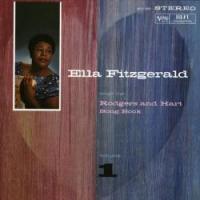Ella Classic As You've Never Heard it
One of the fascinating aspects of collecting records, particularly if you're willing to haunt Goodwills and hit garage sales, are the variations you often find of the same record.
For instance, I picked up at garage sales two stereo copies of Ella Fitzgerald Sings the Rodgers and Hart Songbook Volume I.
One of the fascinating aspects of collecting records, particularly if you're willing to haunt Goodwills and hit garage sales, are the variations you often find of the same record.
For instance, I picked up at garage sales two stereo copies of Ella Fitzgerald Sings the Rodgers and Hart Songbook Volume I.
One is a stereo copy in a mono jacket to which has been affixed a "STEREOPHONIC" sticker. It features the same artwork and annotation as this new ORG double 45.
That is, there is an introduction by Richard Rodgers about his late lyricist Larry Hart reproduced with permission from Simon and Shuster, Inc. from "The Rodgers and Hart Songbook," an Ella appreciation from a "Bill Simon," and a note about the arrangements from producer Norman Granz.
The record inside features the second "T" Verve label after it had been bought by MGM.
The other copy features a stereo cover with a different cover. It's a full cover portrait of a smiling, inviting Ella looking directly into the camera lens, wearing the same dress as in the other photo, obviously taken at the same session.
The graphics on the cover are frillier and appear more "old fashioned." The record inside has the original pre-MGM Verve label.
Clearly, this, not the cover and label ORG used for the reissue, is the true original cover. So why did Verve go from the full cover portrait of the smiling Ella to a smaller, partial cover photo of Ella looking away from the camera, almost like a High School portrait? Was it a racial matter? Was the original cover "too forward" for mid-'50s American sensibilities? Who knows?
Equally intriguing is a comparison of the liner notes. The original's do not include the Richard Rodgers' introduction. Instead, the back cover's first two of three columns are notes written by "WILLIAM SIMON Music Critic.
The notes are similar but not identical and the differences are fascinating. The original annotation begins "It has been a long journey from "A Tisket A Tasket"... The second press notes also used by ORG read "It was a long journey..."
In other words someone decided to go from the passive to the active tense, and to go from the formal "William Simon" to the more friendly "Bill Simon."There are other passive to active tense changes but more interesting are some of the other revisions.
For instance, while the original annotation refers to those responsible for her lack of visibility after her initial success with "A Tisket A Tasket" with "...but much of the blame lies with the people who were responsible for her recordings prior to 1956," the second pressing's notes has "But much of the blame must be placed in the preponderance of bad, desperately "commercial songs..." No more finger pointing at "those people."
The original notes have "Ella asked for and got her own way for just one spare piece of acetate. It turned out to be her hit recording of 'Lady Be Good.' Bop was a big thing with musicians that year and there was an epidemic of scat singing that identified itself superficially with the new music. "Hey Bob A re Bop" and such were the anthems, but Ella managed to put all of that nonsense in its proper perspective when "Lady was released."
The second pressing removes all of Mr. Simon's dismissal of Bop, replacing it with ""Ella asked for and got her own way for just one spare "take." It turned out to be her hit recording of "Lady Be Good."
The original has "Finally, in 1956, she changed her record affiliation." That became "Finally, Ella joined Verve in 1956." Chunks of interesting annotation in the original gave way on the later version to mentions of later Ella "songbook" projects that had yet to be produced when this record, the second in the "songbook" series after "The Cole Porter Song Book, was first issued.
Important stuff? No, but fascinating nonetheless.
As for the music, well, Rodgers and Hart's breezy music and lyrics were made for Ella's musical sensibilities. You can be young and "Broadway-phobic" but you're sure to know some of these classics like "This Can't Be Love," "The Lady is a Tramp," (We'll take) "Manhattan," "Spring is Here," "Johnny One Note." One tune, "Where or When" was covered by everyone from Dion and the Belmonts to The Letterman. The original was performed on Broadway by Ray Heatherton, also known to New York area boomers as "The Merry Mailman" and father of Joey Heatherton. Important? Nah! But interesting!
Ella's readings are equisite, Buddy Bregman's arrangements are swinging, breezy affairs and together they create a magical place where nostalgia and discovery co-exist, aided by a surprisingly superb recording that captures well the timber and texture of Ella's voice, large as life between the speakers. The worst you could say is that the orchestral spread is too wide but that's just looking for something.
Bernie Grundman nails the mastering helping to bring to life a superb project deserving of rejuvenation. There is no way in hell any digital edition of this could sound as genuine as this double 45. Most highly recommended!
Note: This material is also available from Speakers Corner at 33 1/3 with the original cover art and annotation as a double LP set containing Volumes 1 and 2 plus three songs previously unreleased in stereo. The Speakers Corner set was mastered by Kevin Gray and Steve Hoffman and also pressed at Pallas in Germany It too sounds incredibly fine, though it's a bit brighter and less rich-sounding as one might expect from 33 1/3 versus 45rpm mastering.
- Log in or register to post comments




